Bergamo
Bergamo (/ˈbɜːrɡəmoʊ/, also UK: /ˈbɛər-/;[1][2] Italian: [ˈbɛrɡamo] (![]()
![]()
Bergamo | |
|---|---|
| Città di Bergamo | |
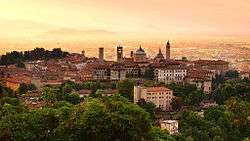 The skyline of the old fortified upper city | |
 Flag 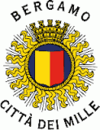 Coat of arms | |
| Nickname(s): Città dei Mille ("City of the Thousand") | |
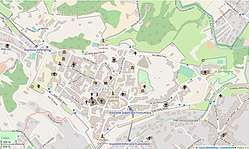 Map of the old walled upper city of Bergamo | |
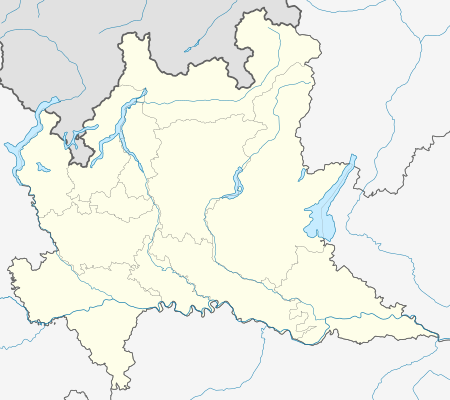 Bergamo Map of the old walled upper city of Bergamo  Bergamo Bergamo (Italy) | |
| Coordinates: 45°41′42″N 9°40′12″E | |
| Area | |
| • Total | 40.16 km2 (15.51 sq mi) |
| Elevation | 485 m (1,591 ft) |
| Population (2019) | |
| • Total | 122,243 |
| Demonym(s) | Bergamasque Bergamaschi (Italian) Bergamàsch (Eastern Lombard) |
| Area code(s) | (+39) 035 |
| Website | www |
| Criteria | Cultural: iii, iv |
| Reference | 1533 |
| Inscription | 2017 (41st session) |
| Area | 378.37 ha |
With a population of approximately 122,000, Bergamo is the fourth-largest city in Lombardy. Bergamo is the seat of the Province of Bergamo. The metropolitan area of Bergamo extends beyond the administrative city limits, spanning over a densely urbanized area with slightly fewer than 500,000 inhabitants.[8] The Bergamo metropolitan area is part of the broader Milan metropolitan area, home to more than eight million people.[9][10][11]
The city of Bergamo is composed of an old walled core, known as Città Alta ("Upper Town"), nestled within a system of hills constituting a regional park, and the modern expansion in the plains below. The upper town is encircled by massive Venetian defensive systems that are a UNESCO World Heritage Site since 9 July 2017.[12]
Bergamo is well connected to several cities in Italy, thanks to the motorway A4 stretching on the axis between Turin, Milan, Verona, Venice, and Trieste. The city is served by Il Caravaggio International Airport, the third-busiest airport in Italy with 13.9 million passengers in 2019. Bergamo is the second most visited city in Lombardy after Milan.[13][14]

History
| Fortified Upper City of Bergamo | |
|---|---|
| Native name Città Alta di Bergamo | |
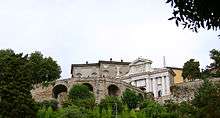 Porta San Giacomo | |
| Location | Bergamo, Natural Park of Bergamo Hills |
| Area | Bergamo, Lombardy, Northern Italy |
| Built | 1561–1588 |
| Governing body | |
| Type | Cultural |
| Criteria | iii, iv |
| Designated | 2017 (41 Session) |
| Part of | Venetian Works of Defence between 15th and 17th centuries: Stato da Terra – western Stato da Mar |
| Reference no. | 1533 |
| Region | Europe and North America |
Celtic Cenomani 550 BC
![]()
![]()
![]()
Visigoths invasion 402
![]()
Huns and Herules invasion 440
![]()
![]()
![]()
![]()
![]()
![]()
![]()
![]()
![]()
![]()
![]()
![]()
![]()
![]()
![]()
![]()
![]()
![]()
Antiquity
Bergamo occupies the site of the ancient town of Bergomum, founded as a settlement by the Celtic tribe of Cenomani. In 49 BC it became a Roman municipality, containing c. 10,000 inhabitants at its peak. An important hub on the military road between Friuli and Raetia, it was destroyed by Attila in the 5th century.
Middle Ages
From the 6th century Bergamo was the seat of one of the most important Lombard duchies of northern Italy, together with Brescia, Trento, and Cividale del Friuli: its first Lombard duke was Wallaris.
After the conquest of the Lombard Kingdom by Charlemagne, it became the seat of a county under one Auteramus (d. 816). An important Lombardic hoard dating from the 6th to 7th centuries was found in the vicinity of the city in the 19th century and is now in the British Museum.[15]
From the 11th century onwards, Bergamo was an independent commune, taking part in the Lombard League which defeated Frederick I Barbarossa in 1165. The local Guelph and Ghibelline factions were the Colleoni and Suardi, respectively.
Feuding between the two initially caused the family of Omodeo Tasso to flee north c. 1250, but he returned to Bergamo in the later 13th century to organize the city's couriers: this would eventually lead to the Imperial Thurn und Taxis dynasty generally credited with organizing the first modern postal service.
Early modern
After a short period under the House of Malatesta starting from 1407, Bergamo was ceded in 1428 by the Duchy of Milan to the Republic of Venice in the context of the Wars in Lombardy and the aftermath of the 1427 Battle of Maclodio.
Despite the brief interlude granted by the Treaty of Lodi in 1454, the uneasy balance of power among the Northern Italian states precipitated the Italian Wars, a series of conflicts from 1494 to 1559 that involved, at various times, also the Papal States, France, and the Holy Roman Empire.[16]
The wars, which were both a result and cause of Venetian involvement in the power politics of mainland Italy, prompted Venice to assert its direct rule over its mainland domains.
As much of the fighting during the Italian Wars took place during sieges, increasing levels of fortification were adopted, using such new developments as detached bastions that could withstand sustained artillery fire.[17]
The Treaty of Campo Formio (17 October 1797) formally recognized the inclusion of Bergamo and other parts of Northern Italy into the Cisalpine Republic, a "sister republic" of the French First Republic that was superseded in 1802 by the short-lived Napoleonic Italian Republic and in 1805 by the Napoleonic Kingdom of Italy.
Late modern and contemporary
The 1815 Congress of Vienna assigned Bergamo to the Kingdom of Lombardy–Venetia, a crown land of the Austrian Empire. The visit of Emperor Ferdinand I in 1838 coincided with the opening of the new boulevard stretching into the plains, leading to the railway station that was inaugurated in 1857.
The Bergamasques welcomed Austrian rule at first, but later challenged it in Italian independentist insurrections in 1848.
Giuseppe Garibaldi conquered Bergamo in 1859, during the Second Italian War of Independence. As a result, the city became part of the newly-proclaimed Kingdom of Italy founded in 1861.
Due to its contribution to the Italian unification movement, Bergamo has become known as Città dei Mille ("City of the Thousand"), because a significant part of the rank-and-file supporting Giuseppe Garibaldi in his 1860 Expedition of the Thousand against the Kingdom of the Two Sicilies came from Bergamo and its environs.
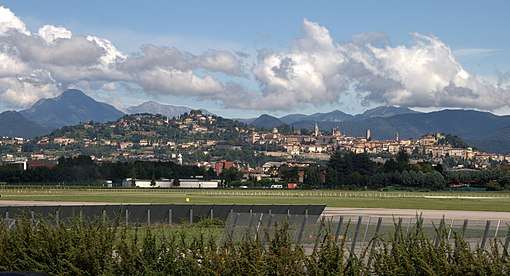
During the twentieth century, Bergamo became one of Italy's most industrialized areas.
In 1907 Marcello Piacentini devised a new urban master plan that was implemented between 1912 and 1927, in a style reminiscent of Novecento Italiano and Modernist Rationalism.
The 2017 43rd G7 summit on agriculture took place in Bergamo, in the context of the broader international meeting organized in Taormina (Sicily).[18] The "Charter of Bergamo", an international commitment signed during the summit, aims to reduce hunger worldwide by 2030, strengthen cooperation for agricultural development in Africa, and ensure price transparency.[19]
In early 2020 during the COVID-19 pandemic in Italy, Bergamo's healthcare system was overwhelmed by patients with COVID-19, the disease caused by the SARS-CoV-2 virus. There were reports of doctors confronted with ethical dilemmas with too few ICU beds and mechanical ventilation systems.[20] Morgues were overwhelmed, and images of military trucks carrying the bodies of COVID-19 victims out of the city were shared worldwide. [21] Doctors pleaded with the rest of Italy, Europe and the world to take the spreading virus pandemic seriously. [22][23]
Geography
Climate
Bergamo has a humid subtropical climate (Cfa in the Koeppen climate classification).
| Climate data for Bergamo (1971–2000, extremes 1946–present) | |||||||||||||
|---|---|---|---|---|---|---|---|---|---|---|---|---|---|
| Month | Jan | Feb | Mar | Apr | May | Jun | Jul | Aug | Sep | Oct | Nov | Dec | Year |
| Record high °C (°F) | 21.9 (71.4) |
22.7 (72.9) |
27.1 (80.8) |
31.9 (89.4) |
35.5 (95.9) |
38.3 (100.9) |
39.0 (102.2) |
37.9 (100.2) |
32.4 (90.3) |
31.5 (88.7) |
23.0 (73.4) |
19.0 (66.2) |
39.0 (102.2) |
| Average high °C (°F) | 6.6 (43.9) |
8.6 (47.5) |
13.0 (55.4) |
16.4 (61.5) |
21.4 (70.5) |
25.3 (77.5) |
28.3 (82.9) |
27.8 (82.0) |
23.4 (74.1) |
17.6 (63.7) |
11.1 (52.0) |
7.2 (45.0) |
17.2 (63.0) |
| Daily mean °C (°F) | 2.7 (36.9) |
4.4 (39.9) |
8.2 (46.8) |
11.4 (52.5) |
16.2 (61.2) |
19.9 (67.8) |
22.8 (73.0) |
22.6 (72.7) |
18.6 (65.5) |
13.3 (55.9) |
7.3 (45.1) |
3.4 (38.1) |
12.6 (54.7) |
| Average low °C (°F) | −1.1 (30.0) |
0.1 (32.2) |
3.3 (37.9) |
6.3 (43.3) |
11.0 (51.8) |
14.5 (58.1) |
17.3 (63.1) |
17.3 (63.1) |
13.8 (56.8) |
9.0 (48.2) |
3.4 (38.1) |
−0.3 (31.5) |
7.9 (46.2) |
| Record low °C (°F) | −15.0 (5.0) |
−20.1 (−4.2) |
−7.7 (18.1) |
−3.6 (25.5) |
1.7 (35.1) |
4.2 (39.6) |
8.9 (48.0) |
8.4 (47.1) |
5.1 (41.2) |
−1.7 (28.9) |
−7.0 (19.4) |
−12.4 (9.7) |
−20.1 (−4.2) |
| Average precipitation mm (inches) | 66.1 (2.60) |
54.0 (2.13) |
71.5 (2.81) |
87.4 (3.44) |
122.5 (4.82) |
121.2 (4.77) |
91.9 (3.62) |
100.3 (3.95) |
114.3 (4.50) |
121.5 (4.78) |
87.5 (3.44) |
64.4 (2.54) |
1,102.6 (43.41) |
| Average precipitation days (≥ 1.0 mm) | 7.1 | 5.3 | 7.0 | 9.3 | 11.1 | 9.1 | 6.3 | 7.2 | 6.5 | 8.3 | 7.1 | 6.6 | 90.9 |
| Average relative humidity (%) | 75 | 75 | 68 | 71 | 69 | 67 | 67 | 68 | 71 | 75 | 78 | 79 | 72 |
| Source: Servizio Meteorologico (humidity 1961–1990)[24][25][26] | |||||||||||||
Cityscape

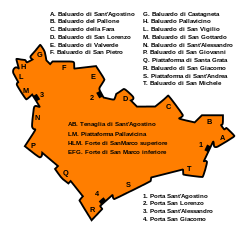
The town has two centres: Città alta ("upper city"), a hilltop medieval town, surrounded by 16th-century defensive walls, and the Città bassa ("lower city"). The two parts of the town are connected by funicular, roads, and footpaths.
Upper city
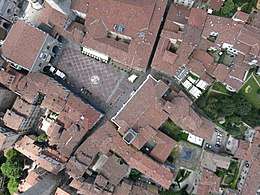
The upper city, surrounded by Venetian walls built in the 16th century, forms the historic centre of Bergamo.[27] Notable buildings within the upper city include:
- Cittadella (Citadel), built under the rule of the Visconti in the mid-14th century.
- Piazza Vecchia
- Palazzo della Ragione. This was the seat of the administration of the city in the medieval municipal period. Built in the 12th century, it was revamped in the late 16th century by Pietro Isabello. The façade has the Lion of Saint Mark over a mullioned window, testifying to the long period of Venetian rule. The atrium has a well-preserved 18th-century sundial.
- Palazzo Nuovo (Biblioteca Civica Angelo Mai). It was designed by Vincenzo Scamozzi in the early 17th century and completed in 1928.
- Basilica di Santa Maria Maggiore. It was built from 1137 on the site of a previous religious edifice of the 7th century. Construction continued until the 15th century. Of this first building the external Romanesque structure and the Greek cross plan remain. The interior was extensively modified in the 16th and 17th centuries. Noteworthy are the great Crucifix and the tomb of Gaetano Donizetti.
- Cappella Colleoni, annexed to Santa Maria Maggiore, is a masterwork of Renaissance architecture and decorative art. It contains the tomb of Bartolomeo Colleoni.
- Battistero (Baptistry), an elegant octagonal building dating from 1340.
- Bergamo Cathedral. It was built in the late 17th century with later modifications.
- Rocca. It was begun in 1331 on the hill of Sant'Eufemia by William of Castelbarco, vicar of John of Bohemia, and later completed by Azzone Visconti. A wider citadel was added, but is now partly lost.
- San Michele al Pozzo Bianco. Built in the 12th century, this church contains several frescoes from the 12th to the 16th centuries, including paintings by Lorenzo Lotto.
- Museo Civico Archeologico. It is housed in the Cittadella.
- Museo di Scienze Naturali Enrico Caffi. It is housed in the Cittadella.
- Orto Botanico di Bergamo "Lorenzo Rota" (botanical garden).
| Parco regionale dei Colli di Bergamo | |
|---|---|
| Regional Park of the Bergamo Hills | |
IUCN category IV (habitat/species management area) | |
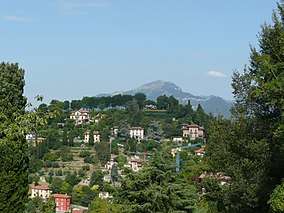 San Vigilio Hill from Città Alta | |
| Location | |
| Area | 11,613 acres (47.00 km2) |
| Established | 1977 |
| Governing body | Parco dei Colli di Bergamo, Regione Lombardia |
| Website | http://parcocollibergamo.it/ITA/Home.asp |
Lower city

The lower city is the modern centre of Bergamo. At the end of the 19th century Città Bassa was composed of residential neighborhoods built along the main roads that linked Bergamo to the other cities of Lombardy. The main boroughs were Borgo Palazzo along the road to Brescia, Borgo San Leonardo along the road to Milan and Borgo Santa Caterina along the road to Serio Valley. The city rapidly expanded during the 20th century. In the first decades, the municipality erected major buildings like the new courthouse and various administrative offices in the lower part of Bergamo in order to create a new center of the city. After World War II many residential buildings were constructed in the lower part of the city which are now divided into twenty-five neighborhoods:

Boccaleone, Borgo Palazzo, Borgo Santa Caterina, Campagnola, Carnovali, Celadina, Centro-Papa Giovanni XXIII, Centro-Pignolo, Centro-Sant'Alessandro, Città Alta, Colli, Colognola, Conca Fiorita, Grumello del Piano, Longuelo, Loreto, Malpensata, Monterosso, Redona, San Paolo, San Tomaso de' Calvi, Santa Lucia, Valtesse-San Colombano, Valverde con Valtesse-Sant'Antonio, Villaggio degli Sposi
The most relevant sites are:
- Accademia Carrara
- Galleria d'Arte Moderna e Contemporanea (GAMeC, Gallery of Modern and Contemporary Art).
Government
Demographics
In 2010, there were 119,551 people residing in Bergamo (in which the greater area has about 500 000 inhabitants), located in the province of Bergamo, Lombardia, of whom 46.6% were male and 53.4% were female. Minors (children ages 18 and younger) totalled 16.79 percent of the population compared to pensioners who number 23.61 percent. This compares with the Italian average of 17.88 percent (minors) and 20.29 percent (pensioners).
The average age of Bergamo residents is 45 compared to the Italian average of 43. In the eight years between 2002 and 2010, the population of Bergamo grew by 5.41 percent, while Italy as a whole grew by 5.77 percent.[28]
The city has sizable immigrant populations in its' bustling industrial economy. They include those from Albania, Romania, Bolivia, China, the Arab World and Sub-Saharan Africa. About 10% of Bergamo residents are born outside Europe.
Economy
Bergamo is situated in Lombardy, Italy's northern region where about a quarter of the country's GDP is produced.[29]
Nowadays, the city has an advanced tertiary economy focussed on banking, retail, and services associated to the industrial sector of its province. Corporations and firms linked to the area include UBI banking group, Brembo (braking systems), Tenaris (steel), ABB (power and automation technology), S. Pellegrino (beverage company based in San Pellegrino Terme), Italcementi (cement and concrete) and Riva-Ferretti (yachts and luxury ships based in Sarnico).
Bergamo produces the Denominazione di origine controllata wines Moscato di Scanzo and Valcalepio.
Culture
Notable natives
Bergamo was the hometown and last resting place of Enrico Rastelli, a highly technical and world-famous juggler who lived in the town and, in 1931, died there at the early age of 34. There is a life-sized statue of Rastelli within his mausoleum. A number of painters were active in the town as well; among these were Giovanni Paolo Cavagna, Francesco Zucco, and Enea Salmeggia, each of whom painted works for the church of Santa Maria Maggiore. Sculptor Giacomo Manzù and the bass-baritone opera singer Alex Esposito[30] were born in Bergamo.
The American electrical engineer and professor Andrew Viterbi, inventor of Viterbi's algorithm, was born in Bergamo, before migrating to the US during the Fascist era because of his Jewish origins. Designers born in Bergamo include the late Mariuccia Mandelli, the founder of Krizia and one of the first female fashion designers to create a successful line of men's wear.[31]
Sports
- Bergamo's football team is Atalanta, who play in the top level Serie A, plays its home games at the Gewiss Stadium.
- The city has a women's volleyball team named Foppapedretti Bergamo.
- The city is also home to the Bergamo Lions American football team, one of the most successful in European Football League history, winning multiple Eurobowls.
- In mid-september, Bergamo hosts the annual Lombardia Trophy, a figure skating event part of the ISU Challenger Series
Education
Transportation

Airport
Bergamo is served by Il Caravaggio International Airport 5 km (3 mi) south-east of the town. The city is also served by Milan Linate Airport 50 km (31 mi) south-west of Bergamo.
Motorway
Motorway A4 is the main axis connecting the city with the east and the west of the country, to cities such as Milan, Turin, Verona, Venice and Trieste.
Railway
Bergamo railway station is connected to Milan, Lecco, Cremona, Treviglio, Brescia and Monza with regional trains operated by Trenord. The city is also served by two daily Frecciargento services to Rome operated by Trenitalia.
Urban transport
Transport within Bergamo is managed by ATB and includes a network of bus lines together with two funicular systems opened in 1887 ("Funicolare di Bergamo Alta") and in 1912 ("Funicolare di Bergamo Alta - Monte San Vigilio"). The Bergamo–Albino light rail was inaugurated in 2009.
Two light rail lines are currently in the planning stage:
- Line 2 Bergamo FS - Villa d'Almè - San Pellegrino Terme
- Line 3 Hospital-Railway Station FS-Trade Fair - Bergamo Airport
International relations
Twin towns − sister cities
Bergamo is twinned with:[32]








Bergamo has a partnership with:



Notable people
- Giovanni Michele Alberto da Carrara
- Gaetano Donizetti
- Gianandrea Gavazzeni
- Matteo Guerinoni
- Pietro Locatelli
- Lorenzo Lotto
- Giacomo Manzù
- Alfredo Piatti
- Andrea Previtali
Notes
- Historical German: Welschbergen or Wälsch-Bergen,[3][4][5] from the common Germanic *berg + *heim, "mountain home".[6][7]
References
- Wells, John C. (2008). Longman Pronunciation Dictionary (3rd ed.). Longman. ISBN 978-1-4058-8118-0.
- Upton, Clive; Kretzschmar, Jr., William A. (2017). The Routledge Dictionary of Pronunciation for Current English (2nd ed.). Routledge. p. 124. ISBN 978-1-138-12566-7.
- "Relation History: Bergamo (45681)". OpenStreetMap. Retrieved 8 April 2019.
- Büsching, Anton Friedrich (1797). Anton Friedrich Büschings Erdbeschreibung: welcher Amerika begreist. Die vereinten Staaten von Nordamerika. Siebenter Theil. Vierter Band (in German). bey Carl Ernst Bohn.
- Schleswigsches Journal: 1792,3 (in German). Korten. 1792.
- "L'ETIMOLOGIA DI BERGAMO". ROSEBUD - Arts, Critique, Journalism (in Italian). 3 November 2013. Retrieved 15 August 2018.
- "Comune di Bergamo (BG)". www.comune.bergamo.it. Archived from the original on 3 May 2014. Retrieved 15 August 2018.
- "Urbanismi in Italia, 2011" (PDF). cityrailways.it (in Italian). Archived from the original (PDF) on 10 November 2011. Retrieved 4 November 2014.
- "OECD Territorial Review - Milan, Italy".
- "Archived copy" (PDF). Archived from the original (PDF) on 5 December 2008. Retrieved 22 March 2015.CS1 maint: archived copy as title (link) Competitiveness of Milan and its metropolitan area
- ISTAT
- Centre, UNESCO World Heritage. "The city of Bergamo - UNESCO World Heritage Centre". whc.unesco.org. Retrieved 2 November 2017.
- "RSY Lombardia-Arrivals and nights spent by guests in accommodation establishments, by type of resort and by type of establishment. Total accommodation establishments. Part III. Tourist resort. Year 2012". asr-lombardia.it. Archived from the original on 4 November 2014. Retrieved 4 November 2014.
- "Lombardia, Pil più alto in Italia Bergamo disoccupazione ai minimi" (in Italian). Retrieved 11 October 2017.
- "Collection search: You searched for". British Museum.
- Michael Mallett and Christine Shaw, The Italian Wars: 1494–1559. Harlow: Pearson Education Limited, 2012.
- Max Boot, War Made New: Technology, Warfare, and the Course of History, 1500 to Today. New York: Penguin Group, 2006.
- "G7 Agricoltura, approvata la Carta di Bergamo: "Zero fame entro il 2030"". Repubblica.it (in Italian). 15 October 2017. Retrieved 16 October 2017.
- "G7, nasce la Carta di Bergamo: cooperazione, trasparenza sui prezzi e lotta allo spreco alimentare". BergamoNews (in Italian). 15 October 2017. Retrieved 16 October 2017.
- "Special Report: 'All is well'. In Italy, triage and lies for virus patients". Reuters. 16 March 2020. Retrieved 17 March 2020.
- Bostock, Bill. "Video shows Italian army trucks transporting coffins from Italy's worst-hit city to remote cremation sites because morgues can't cope with more coronavirus deaths". Business Insider. Business Insider. Retrieved 15 June 2020.
- "A coronavirus cautionary tale from Italy: Don't do what we did - The Boston Globe". BostonGlobe.com. Retrieved 17 March 2020.
- "'It's Like a War'". The New York Times. 17 March 2020. ISSN 0362-4331. Retrieved 17 March 2020.
- "Bergamo/Orio Al Serio (BG)" (PDF). Atlante climatico. Servizio Meteorologico. Retrieved 6 March 2015.
- "STAZIONE 076 Bergamo Orio Al Serio: medie mensili periodo 61 - 90". Servizio Meteorologico. Retrieved 6 March 2015.
- "Bergamo Orio al Serio: Record mensili dal 1946" (in Italian). Servizio Meteorologico dell’Aeronautica Militare. Retrieved 6 March 2015.
- "The city of Bergamo". UNESCO World Heritage Centre. Retrieved 1 February 2015.
- "Statistiche demografiche ISTAT". Demo.istat.it. Retrieved 15 April 2012.
- "European Commission - PRESS RELEASES - Press release - Regional GDP per inhabitant in the EU27
GDP per inhabitant in 2006 ranged from 25% of the EU27 average in Nord-Est in Romania to 336% in Inner London". europa.eu. Retrieved 8 October 2017. - "Alex Esposito". www.roh.org.uk. Royal Opera House. Retrieved 25 February 2014.
- Fox, Margalit (7 December 2015). "Mariuccia Mandelli, Italian Fashion Designer, Dies at 90". The New York Times. Retrieved 4 January 2016.
- "Bergamo". efus.eu. European Forum for Urban Security. Retrieved 22 December 2019.
- "Posadas y sus hermanas" (in Spanish). Primera Edición. Archived from the original on 2 April 2015. Retrieved 28 March 2015.
- Consolato Onorario della BOLIVIA "Easydiplomacy" Archived 1 January 2012 at the Wayback Machine
- "Consolato Onorario del Malawi a Bergamo > Company Profile | Guida Monaci". Archived from the original on 5 November 2014. Retrieved 5 November 2014.
- "Rappresentanze svizzera in Italia". www.eda.admin.ch.
Bibliography
External links
| Wikimedia Commons has media related to Bergamo. |
| Wikivoyage has a travel guide for Bergamo. |
- Municipality of Bergamo official website (in Italian)
- Visit Bergamo
